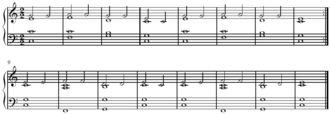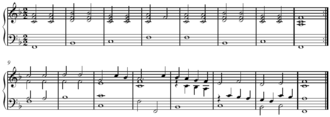Bergamask
Bergamask, bergomask, bergamesca,[1] or bergamasca (from the town of Bergamo in Northern Italy), is a dance and associated melody and chord progression.
Reputation
It was considered a clumsy rustic dance (cf. Shakespeare, A Midsummer Night's Dream, Act V Scene i Lines 341 and 349) copied from the natives of Bergamo, reputed, according to the Encyclopædia Britannica Eleventh Edition, to be very awkward in their manners.[2]
The dance is associated with clowns or buffoonery, as is the area of Bergamo, it having lent its dialect to the Italian buffoons.[1]
Chord progression
The basic chord progression is I–IV–V–I:[3]
Bergomask is the title of the second of the Two Pieces for Piano (1925) by John Ireland (1879–1972).
gollark: Idea: submit 1000 holiday concepts and hope that TJ09 has too little time to read other people's.
gollark: Multicoloured static.
gollark: Coppers. Coppers, coppers. Coopers coppers.
gollark: NEVER.
gollark: Wow! I got what I asked for and wanted on the hub!
See also
- Moresca
- Romanesca
- Masques et bergamasques
- Suite bergamasque
Sources
- (1916). The Musical Times, Volume 57, p.491.
-

- Apel, Willi (1969). Harvard Dictionary of Music, p.91. ISBN 978-0-674-37501-7.
This article is issued from Wikipedia. The text is licensed under Creative Commons - Attribution - Sharealike. Additional terms may apply for the media files.

